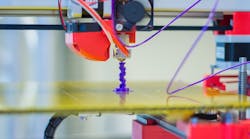A two-year study from Underwriters Laboratory examines the implications of ultrafine particles and volatile organic compounds released during 3D printing on human health. Although enclosures and other features on 3D printers are usually included to minimize the release of airborne particles during extrusion, further investigation is needed to develop standards that will ensure the safety of people in the area.
UL presented its results at the Summit on the Safety Science of 3D Printing. Its study explores several polymer filaments, including ABS and PLA, which produce similar levels of ultrafine particles. They identified 50 volatile organic compounds (VOCs) released during printing, of which the most significant were styrene, caprolactam, and lactide.
“Emissions from 3D printing can be a source of ultrafine particles in the nanoparticle size range as well as a source of certain VOCs, some of which are odorants, irritants, and chronic or acute hazards,” writes Marilyn Black, VP and Senior Technical Advisor at UL. “These exposure levels are generally low and complete risk assessments have not been conducted, but a precautionary approach of providing good building ventilation with outdoor air exchange and local ventilation in areas where 3D printing is occurring would be prudent.”
UL will continue to study different filament to assess toxicity and emissions, and also begin to develop American National Standards Institute (ANSI) standards for measuring and assessing printer emissions indoors. The study was presented at the Safety Science of 3D printing Summit, February 22-23, in Atlanta, Georgia. It was conducted with partners Georgia Institute of Technology and Emory University Rollins School of Public Health.
About the Author
Leah Scully
Associate Content Producer
Leah Scully is a graduate of The College of New Jersey. She has a BS degree in Biomedical Engineering with a mechanical specialization. Leah is responsible for Machine Design’s news items that cover industry trends, research, and applied science and engineering, along with product galleries. Visit her on Facebook, or view her profile on LinkedIn.

